Viola missouriensis Greene
Common names:
Missouri Violet
Synonyms:
Viola missouriensis Greene, Pittonia 4: 141. 1900; Viola sororia Willd. var. missouriensis (Greene) L.E.McKinney, Sida, Bot. Misc. 7: 42. 1992. TYPE: USA, Missouri [Jackson Co.], Courtney, Common in sandy bottoms, Flowers white, 30 Apr 1899, B. F. Bush 70 (LECTOTYPE (designated incorrectly as holotype by Landon McKinney, Sida, Bot. Misc. 7: 42. 1992, corrected by Nir Gil-ad, Boissiera 53: 63. 1997): NY00029621!; ISOLECTOTYPES: NY00029619!, NDG33214B, internet image!, MO-1889077!).
Viola illinoensis Greene, Pittonia 4: 293. 1901
Viola securigera Greene, Pittonia 5: 29. 1902
Viola candidula Nieuwl., Amer. Midl. Naturalist 3: 85, pl. 2, 3. 1913
Viola lucidifolia Newbro, Stud. Nat. Hist. Iowa Univ. 17: 56, pl. 4, fig. 3, pl. 8, figs. 24-25. 1936
Description:
Acaulescent rosulate perennials from thick rhizome, ≤ 40 cm tall; foliage and peduncles green, glabrous throughout; stipules free, irregularly glandular-fimbriate; leaves ascending, leaf blades undivided, largest ≤ 78 × 64 mm, in spring distinctly longer than broad and triangular-acuminate to deltate-ovate or narrowly ovate-triangular, in summer broadening to about as broad as long or broader and deltate- or ovate-triangular, base subcordate to shallowly cordate, margins serrate in basal 2/3, subentire or low-serrate and more remote near apex, eciliate, apex sharply acute to acuminate; chasmogamous peduncle often overtopping leaves; chasmogamous flower ≤ 21 mm; calyx glabrous, ciliolate; lowest sepals oblong to ovate-lanceolate, obtuse to rounded; auricles short and entire, weakly elongating to 2 mm in fruit; corolla violet, area around throat white often with a slightly darker flush surrounding it, throat white; spur short-globose; lateral petals densely bearded with hairs narrowly linear or slightly to distinctly broadened apically, spurred petal glabrous; chasmogamous capsule green; cleistogamous flowers produced after chasmogamous, on prostrate or flexuous peduncles arching upward just before capsule dehiscence, shorter than petioles; cleistogamous capsule 7–12 mm, green drying to tan with purple spots or blotches, glabrous; seeds 1.5–2.2 × 1.0–1.3 mm, medium orange-brown, unspotted or more commonly with small weak darker streaks, blotches and spots.
Similar species:
Generally, this will be most similar to other Borealiamericanae with strictly or essentially glabrous foliage and narrowly ovate-triangular leaf blades in spring that broaden substantially in summer but will differ most obviously in its strictly glabrous leaf blades with the apical portion somewhat attenuate and subentire or with remote very low teeth, and narrowly rounded and usually ciliolate sepals. In chasmogamous flower, this species can be distinguished from V. affinis additionally by its glabrous spurred petal; from Viola cucullata by its short rounded auricles, lack of a conspicuously contrasting dark purple eyespot around the throat, and lateral petal beards with long narrowly linear to weakly clavate hairs; from V. langloisii by its strongly ascending to erect leaves, and short rounded auricles; and from V. pratincola and V. retusa by its short rounded auricles. In cleistogamous fruit, it can be separated from V. communis, V. cucullata, V. pratincola and V. retusa by its heavily spotted or blotched cleistogamous capsule on a prostrate peduncle, and orange-brown unspotted or weakly marked seeds; from V. langloisii by its prostrate capsule peduncle and rounded ciliolate sepals; and from Viola sororia [glabrous variant] and Viola sororia [hirsutuloides variant] by its ciliolate sepals and orange-brown unspotted seeds.
Ecology:
Sandy soils of bottomland forests along streams, rivers and lakeshores.
Distribution:
W. Midwest, Great Plains and Lower Midwest, c. IN to MN, south to w. MS, e. TX, NE.
Rarity:
None.
Phenology:
Chasmogamous flower April–June (October-November), chasmogamous fruit May–July, cleistogamous fruit May–September.
Affinities:
This species belongs to the Acaulescent Blue Violet lineage, sect. Nosphinium W.Becker, subsect. Boreali-Americanae (W.Becker) Gil-ad, in the Affinis species group.
Hybrids:
Hybridizes with V. pedatifida (Ballard 2013), V. sororia (Brainerd 1924), and V. viarum (Russell 1965, Ballard 2013). Hybrids with other species are possible and should be sought. Brainerd reported that these exhibit intermediate or recombinant characteristics of foliage, chasmogamous flowers, cleistogamous capsules and seeds (where these did not abort). Brainerd reported that the hybrid with V. sororia failed to reproduce by chasmogamous flowers and cleistogamous capsules contained only a few viable seeds. Studies are needed on the reproductive behavior of the other hybrids.
Comments:
This species was accepted by Brainerd (1921b), Brainerd Baird (1942), Fernald (1950), Alexander (1963), Russell (1965), Swink and Wilhelm (1979), Gil-ad (1995, 1997, 1998), and Ballard (2013). Gleason and Cronquist (1991) submerged it in V. sororia. McKinney (1992) and McKinney and Russell (2002) maintained it as a variety under V. sororia while Little and McKinney (2015) reinstated it as a species. Gil-ad and Little and McKinney suggested that southern V. langloisii Greene was conspecific with the present species and included it; however, they were evidently unaware of several differences exhibited by V. langloisii, including an eciliate calyx, linear-lanceolate acuminate sepals, prominent auricles weakly elongating in fruit, and green unspotted cleistogamous capsules on declined peduncles. Russell (1958a) studied the morphology and ecology of this species. The present species is readily separated from V. affinis, with which it is most often confused, by its strictly glabrous foliage, glabrous spurred petal, ciliolate calyx, and obtuse to (narrowly) rounded sepal apices. See V. affinis for further comments on distinctions, ecological differences and morphological integrity in the region of sympatry. This and other members of the Affinis species group are currently under study by Remington Burwell at Ohio University.
Literature Cited:
Alexander, E. J. 1963. Violaceae. In Gleason, H. A., The new Britton and Brown illustrated flora of the northeastern United States and adjacent Canada. Hafner Publishing Co., Inc., New York, NY. 552-567.
Ballard Jr., H. E. 2013. Violaceae. In Yatskievych, G., Flora of Missouri. Missouri Botanical Garden Press, St. Louis, MO. 1218-1243.
Brainerd, E. 1921b. Violets of North America. Vermont Agricultural Experiment Station Bulletin 224: 1-172.
Brainerd, E. 1924. The natural violet hybrids of North America. Vermont Agricultural Experiment Station Bulletin 239.
Brainerd Baird, V. 1942. Wild violets of North America. University of California Press, Berkeley, CA.
Fernald, M. L. 1950. Violaceae. In Gray’s Manual of Botany, 8th ed. American Book Company, New York, NY. 1022-1042.
Gil-ad, N. L. 1995. Systematics and evolution of Viola L. subsection Boreali-Americanae (W. Becker) Brizicky. Ph.D. dissertation. University of Michigan, Ann Arbor, MI.
Gil-ad, N. L. 1997. Systematics of Viola subsection Boreali-Americanae. Boissiera 53: 1-130.
Gil-ad, N. L. 1998. The micromorphologies of seed coats and petal trichomes of the taxa of Viola subsect. Boreali-Americanae (Violaceae) and their utility in discerning orthospecies from hybrids. Brittonia 50: 91-121.
Gleason, H. A. and A. Cronquist. 1991. Violaceae. In Manual of vascular plants of northeastern United States and adjacent Canada, 2nd ed. New York Botanical Garden, Bronx, NY. 157-163.
Little, R. J., and L. E. McKinney. 2015. Violaceae. In Flora of North America: Cucurbitaceae to Droseraceae, 106. Oxford University Press, New York, NY.
McKinney, L. E. 1992. A taxonomic revision of the acaulescent blue violets (Viola) of North America. Sida, Botanical Miscellany 7: 1-60.
McKinney, L. E., and N. H. Russell. 2002. Violaceae of the southeastern United States. Castanea 67: 369-379.
Russell, N. H. 1958a. The nature of Viola missouriensis. Proceedings of the Iowa Academy of Science 65: 96-101.
Russell, N. H. 1965. Violets (Viola) of the central and eastern United States: An introductory survey. Sida 2: 1-113.
Swink, F. and G. Wilhelm. 1979. Violaceae. In Plants of the Chicago region, 2nd ed. revised and expanded. Morton Arboretum, Lisle, IL. 384, 801-810.
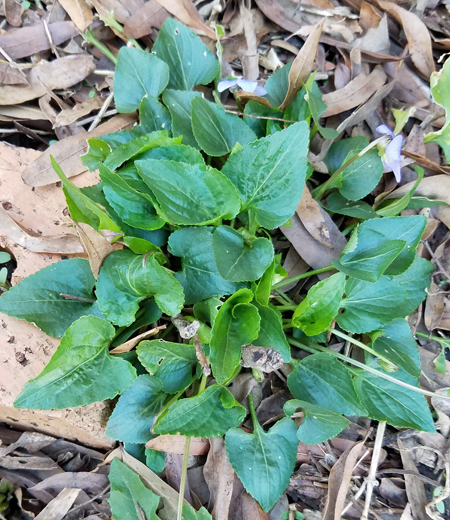
Chasmogamous flowering habit by Harvey Ballard
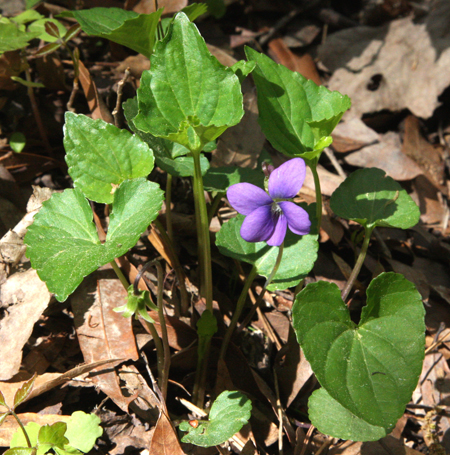
Chasmogamous flowering habit by Bruce Sorrie
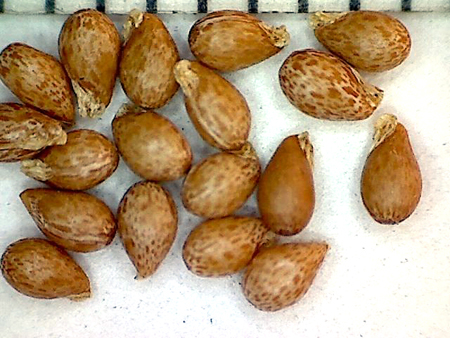
Seeds from herbarium specimen: [Transplanted from] MO, [B. F. Bush donor], Garden, Middlebury, VT, 30 Aug 1905, E. Brainerd s.n. (NY)
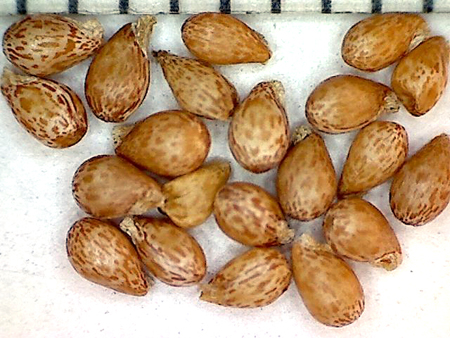
Seeds from herbarium specimen: OK, near Ft. Gibson, Flat land along Flower Creek, 13 Apr 1910, E. Brainerd 82 (NY)
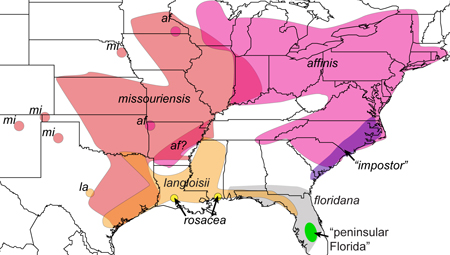
Map of the Affinis species group by Harvey Ballard